भारत के भूगोल
एह लेख के भोजपुरी में अनुवाद के जरूरत बाटे। ई लेख (या एकर कुछ हिस्सा) भोजपुरी की अलावे दूसर भाषा में लिखल बा। |
 | |
| महादीप | एशिया |
|---|---|
| क्षेत्र | दक्खिन एशिया भारतीय उपमहादीप |
| लोकेशन | 21°N 78°E / 21°N 78°E |
| रकबा | Ranked 7वाँ |
| • कुल | 3,287,263 किमी2 (1,269,219 वर्ग मील) |
| • जमीन | 90.08% |
| • पानी | 9.92% |
| तटरेखा | 7,516.6 किमी (4,670.6 मील) |
| सीमा | कुल जमीनी बार्डर:[1] 15,106.70 किमी (9,386.87 मील) बंगलादेश: 4,096.70 किमी (2,545.57 मील) चीन (पीआरसी): 3,488 किमी (2,167 मील) पाकिस्तान: 2,910 किमी (1,808 मील) नेपाल: 1,751 किमी (1,088 मील) म्यामांर: 1,643 किमी (1,021 मील) भूटान: 699 किमी (434 मील) |
| सभसे ऊँच जगह | कंचनजंघा 8,598 मी (28,209 फीट) |
| सभसे निचाई के जगह | कुट्टनाड −2.2 मी (−7.2 फीट) |
| सबसे लमहर नदी | गंगा, ब्रह्मपुत्र |
| सबसे बड़हन झील | चिल्का झील |
भारत में बिबिध प्राकृतिक आ मानवीय चीजन के जगह भा क्षेत्र अनुसार बितरण, यानी कि भारत के भूगोल, हर तरह से बहुत विविधता वाला बाटे। एशिया महादीप के दक्खिनी हिस्सा में मौजूद भारत देस के भूगोलीय लोकेशन भूमध्य रेखा के 8°4' उत्तर (मुख्य भूमि) से 37°6' अक्षांस ले आ 68°7' पुरुब से 97°25' पुरुब देशांतर ले बाटे।[2] ई बिस्व के सातवाँ सभसे बड़हन देस हवे जेकर कुल एरिया 3,287,263 वर्ग किलोमीटर (1,269,219 वर्ग मील) बाटे।[3][4][5] भारत के उत्तर-दक्खिन के लंबाई 3,214 किमी (1,997 मील) आ पुरुब-पच्छिम के चौड़ाई 2,933 किमी (1,822 मील) बाटे आ एकर जमीनी सीमा 15,200 किमी (9,445 मील) आ समुंद्री तटरेखा 7,516.6 किमी (4,671 मील) बा।[1]
भारत के उत्तर में हिमालय के बहुते ऊँच पहाड़ बाटे आ दक्खिन में प्रायद्वीप वाला हिस्सा में ऊबड़-खाबड़ पठार मिलेला। दक्खिन में, भारत हिंद महासागर में आगे के ओर निकसल बा आ एही महासागर से घेराइल बाटे - एकरा पच्छिम में अरब सागर, दक्खिन-पच्छिम में लक्षदीप सागर, पूरुब में बंगाल के खाड़ी आ ठीक दक्खिन में हिंद महासागर बाटे। पाक जलजोड़ आ मन्नार के खाड़ी एकरा के श्रीलंका से अलगा करे लीं जे लगहीं दक्खिन पछिम में बाटे आ मालदीव एकरा लक्षदीप से लगभग 125 किलोमीटर (78 मील) दूरी पर दक्खिन में बा जे आठ डिग्री चैनल द्वारा अलग कइल जाला। भारत के अंडमान आ निकोबार दीपसमूह एकरा मुख्य भूमि से लगभग 1,200 किलोमीटर (750 मील) दक्खिनपुरुब में पड़े ला, ई म्यांमार, थाईलैंड आ इंडोनेशिया से समुंद्री सीमा सझिया करे लें। भारत के मुख्यभूमि के सभसे दक्खिनी बिंदु कन्याकुमारी के ठीक दक्खिन में (8°4′38″N, 77°31′56″E) बाटे आ दीपीय हिस्सा के सामिल कइल जाय तब ग्रेट निकोबार दीप पर इंदिरा प्वाइंट सभसे दक्खिनी बिंदु हवे। भारत के अधिकार वाला हिस्सा में सभसे उत्तरी बिंदु इंदिरा कॉल हवे जे सियाचिन ग्लेशियर क्षेत्र में बाटे। [6] भारत के टेरीटोरियल जलक्षेत्र समुंद्र में तट के बेसलाइन से 12 समुंद्री मील (13.8 मील; 22.2 किमी) के दूरी ले बाटे।[7] भारत के एक्सक्लूजिव इकोनामिक ज़ोन 18वाँ सभसे बड़हन हवे जे 2,305,143 किमी2 (890,021 वर्ग मील) के बिस्तार वाला बाटे।
भारत के उत्तरी सीमा बहुधा हिमालय परबत श्रेणी द्वारा तय होखे ले जे चीन, भूटान आ नेपाल के संघे बा। भारत-पाकिस्तान सीमा उत्तर में काराकोरम परबत, पच्छिमी हिमालय, पंजाब के मैदान,थार के रेगिस्तान आ कच्छ के रन समुंद्री नमकीन दलदल वाला इलाका ले बाटे। सुदूर पूर्बोत्तर में चिन आ कचिन के गम्हीर बन क्षेत्र वाली पहाड़ी श्रेणी सभ भारत आ म्यांमार केबीचा में सीमा बनावे लीं। पुरुब ओर एकर बांग्लादेश के साथे सीमा उत्तरी हिस्स्सा में खासी आ मिजो पहाड़ी से बने ले, बाकी सीमा गंगा-ब्रह्मपुत्र के मैदानी हिस्सा से गुजरे ले।
गंगा भारत में निकलेवाली एहिजा के सभसे लमहर नदी हवे। गंगाब्रह्मपुत्र सिस्टम एकरे अधिकांस उत्तरी, बिचला आ पुरबी हिस्सा के कभर करे ला जबकि दक्कन के पठार दक्खिनी हिस्सा के कभर करे ला। सिक्किम में भारत के सभसे ऊँच परबत चोटी 8,586 मी (28,169 फीट) ऊँचाई वाली बाटे आ ई दुनियाँ के तिसरी सभसे ऊँच चोटी हवे। गिलगित बल्तिस्तान में माउंट के2 दुनिया के दुसरी सभसे ऊँच छोटी हवे, हालाँकि, ई वर्तमान में पाकिस्तान के अधिकार में बाटे। भारत के जलवायु में मजिगर बिबिधता देखे के मिले ला; दक्खिन में भूमध्य रेखीय जलवायु से ले के उत्तर में अल्पाइन आ टुंड्रा जलवायु मिले ले जबकि पच्छिम में थार के सूखल रेगिस्तानी जलवायु बाटे। भूबैग्यानिक हिसाब से भारत भारतीय प्लेट पर स्थित बाटे जे खुद इंडो-ऑस्ट्रेलियन प्लेट के उत्तरी हिस्सा हवे।
राजनैतिक बिभाजन
[संपादन करीं]भारत में 28 गो राज्य आ 8 गो संघ राज्यक्षेत्र (केंद्र शासित प्रदेश) बाने। राज्यन के नाँव नीचे दिहल जात बाटे (कोष्टक में राजधानी के नाम):

- संघ राज्यक्षेत्र (केन्द्रशासित प्रदेश)
|
† चंडीगढ़ एक ठो केंद्रशासित प्रदेश हवे आ ई पंजाब आ हरियाणा दुन्नों राज्यन के राजधानी भी हऽ।
Physiographic regions
[संपादन करीं]
Cratons
[संपादन करीं]
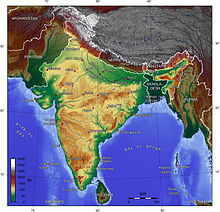

Cratons are a specific kind of continental crust made up of a top layer called platform and an older layer called basement. A shield is the part of a craton where basement rock crops out of the ground, and it is relatively the older and more stable section, unaffected by plate tectonics.[8][9]
The Indian Craton can be divided into five major cratons as such:
- Aravalli Craton (Marwar-Mewar Craton or Western Indian Craton): Covers Rajasthan as well as western and southern Haryana. It comprises Mewar Craton in the east and Marwar Craton in the west. It is limited by the Great Boundary Fault in the east, sandy Thar Desert in the Thar desert in the west, Indo-ganetic alluvium in the north, Son-Narmada-Tapti in the south. It mainly has quartzite, marble, pelite, greywacke and extinct volcanos exposed in Aravalli-Delhi Orogen. Malani Igneous Suite is the largest in India and third largest igneous suite in the world.
- Bundelkand Craton, covers 26,00 km2 in the Bundelkhand region of Uttar Pradesh and Madhya Pradesh and forms the basis of the Malwa Plateau. It is limited by the Aravalli in the west, Narmada river and Satpura range in the south, and Indo-Gantetic alluvium in the north. It is similar to the Aravali Craton, which used to be a single craton before being divided into two with the evolution of Hindoli and Mahakoshal belts at the margins of two cratons.
- Dharwar Craton (Karnataka Craton), 3.4 - 2.6 Ga, granite-greenstone terrain covers the state of Karnataka and parts of eastern and southern Maharashtra state, and forms the basis of the southern end of the Deccan Plateau. In 1886 it was divided into two tectonic blocks, namely Eastern Dharwar Craton (EDC) and Western Dharwar Craton (WDC).
- Singhbhum Craton, 4,000 km2 area which primarily covers Jharkhand as well as parts of Odisha, northern Andhra Pradesh, northern Telangana and eastern Maharashtra. It is limited by the Chhota Nagpur Plateau to the north, Eastern Ghats to the southeast, Bastar Craton to southwest and alluvium plain to the east.
- Bastar Craton (Bastar-Bhandara Craton), primarily covers Chhattisgarh and forms the basis of the Chhota Nagpur Plateau. It is a remnant of 3.4-3.0 Ga old TTG gneisses of five types. It is subdivided into Kotri-Dongagarh Orogen and the Rest of Bastar Craton. It is limited by three rifts, Godavari rift in southwest, Narmada rift in northwest and Mahanadi rift in northeast.
Regions
[संपादन करीं]India can be divided into six physiographic regions. They are:
- Northern Mountains: Himalayas
- Peninsular Plateau: contains mountain ranges (Aravalli, Vindhayachal and Satpura ranges), ghats (Eastern Ghats and Western Ghats) and plateaues (Malwa Plateau, Chhota Nagpur Plateau, Southern Garanulite terrain, Deccan Plateau and Kutch Kathiawar plateau).
- Indo-Gangetic Plain or The Northern Plains
- Thar Desert
- Coastal Plains: Eastern Ghat folds and Western Ghats folds
- Islands- The Andaman and Nicobar islands and the Lakshadweep islands.
The Himalayas
[संपादन करीं]An arc of mountains consisting of the Himalayas, Hindu Kush, and Patkai ranges define the northern frontiers of the Indian subcontinent.[10] These were formed by the ongoing tectonic plates collision of the Indian and Eurasian plates. The mountains in these ranges include some of the world's tallest mountains which act as a barrier to cold polar winds. They also facilitate the monsoon winds which in turn influence the climate in India. Rivers originating in these mountains flow through the fertile Indo–Gangetic plains. These mountains form the boundary between two biogeographic realms: the temperate Palearctic realm that covers most of Eurasia, and the tropical and subtropical Indomalayan realm which includes South Asia, Southeast Asia and Indonesia.[प्रमाण देईं]

The Himalayas in India extend from the Indian-administered region of Ladakh in the north to the state of Arunachal Pradesh in the east. Several Himalayan peaks in India rise above 7,000 मी (23,000 फीट), including Kanchenjunga (8,598 मी (28,209 फीट)) on the Sikkim–Nepal border, and Nanda Devi (7,816 मी (25,643 फीट)) in the Garhwal Himalayas of Uttarakhand. The snow line ranges between 6,000 मी (20,000 फीट) in Sikkim to around 3,000 मी (9,800 फीट) in Ladakh. The Himalayas act as a barrier to the frigid katabatic winds flowing down from Central Asia. Thus, northern India is kept warm or only mildly cooled during winter; in summer, the same phenomenon makes India relatively hot.[प्रमाण देईं]
- The Karakoram range runs through Ladakh. The range is about 500 किमी (310 मील) in length and the most heavily glaciated part of the world outside of the polar regions. The Siachen Glacier at 76 किमी (47 मील) ranks as the world's second longest glacier outside the polar regions.[11] The southern boundary of the Karakoram is formed by the Indus and Shyok rivers, which separate the range from the northwestern end of the Himalayas.
- The Patkai, or Purvanchal, are situated near India's eastern border with Burma. They were created by the same tectonic processes which led to the formation of the Himalayas. The physical features of the Patkai mountains are conical peaks, steep slopes and deep valleys. The Patkai ranges are not as rugged or tall as the Himalayas. There are three hill ranges that come under the Patkai: the Patkai–Bum, the Garo–Khasi–Jaintia and the Lushai hills. The Garo–Khasi range lies in Meghalaya. Mawsynram, a village near Cherrapunji lying on the windward side of these hills, has the distinction of being the wettest place in the world, receiving the highest annual rainfall.[12]

The Peninsular Plateau
[संपादन करीं]The main features of Indian Craton are:
- Mountain ranges (clockwise from top-left)
- Aravali Range is the oldest mountain range in India, running across Rajasthan from northeast to southwest direction, extending approximately 800 किमी (500 मील).[13] The northern end of the range continues as isolated hills and rocky ridges into Haryana, ending near Delhi. The highest peak in this range is Guru Shikhar at Mount Abu, rising to 1,722 मी (5,650 फीट), lying near the border with Gujarat.[14] The Aravali Range is the eroded stub of an ancient fold mountain system.[15] The range rose in a Precambrian event called the Aravali–Delhi orogen. The range joins two of the ancient segments that make up the Indian craton, the Marwar segment to the northwest of the range, and the Bundelkhand segment to the southeast.
- Vindhya range, lies north of Satpura range and east of Aravali range, runs across most of central India, extending 1,050 किमी (650 मील).[16] The average elevation of these hills is from 300 से 600 मी (980 से 1,970 फीट) and rarely goes above 700 मीटर (2,300 फीट).[16] They are believed to have been formed by the wastes created by the weathering of the ancient Aravali mountains.[17] Geographically, it separates Northern India from Southern India. The western end of the range lies in eastern Gujarat, near its border with Madhya Pradesh, and runs east and north, almost meeting the Ganges at Mirzapur.

Dry deciduous and thorny forests of plateau regions in India - Satpura Range, lies south of Vindhya range and east of Aravali range, begins in eastern Gujarat near the Arabian Sea coast and runs east across Maharashtra, Madhya Pradesh and Chhattisgarh. It extends 900 किमी (560 मील) with many peaks rising above 1,000 मी (3,300 फीट).[16] It is triangular in shape, with its apex at Ratnapuri and the two sides being parallel to the Tapti and Narmada rivers.[18] It runs parallel to the Vindhya Range, which lies to the north, and these two east–west ranges divide the Indo–Gangetic plain from the Deccan Plateau located north of River Narmada.
- Plateaus (clockwise from top-left)
- Malwa Plateau is spread across Rajasthan, Madhya Pradesh and Gujarat. The average elevation of the Malwa plateau is 500 metres, and the landscape generally slopes towards the north. Most of the region is drained by the Chambal River and its tributaries; the western part is drained by the upper reaches of the Mahi River.
- Chhota Nagpur Plateau is situated in eastern India, covering much of Jharkhand and adjacent parts of Odisha, Bihar and Chhattisgarh. Its total area is approximately 65,000 किमी2 (25,000 वर्ग मील) and is made up of three smaller plateaus—the Ranchi, Hazaribagh, and Kodarma plateaus. The Ranchi plateau is the largest, with an average elevation of 700 मी (2,300 फीट). Much of the plateau is forested, covered by the Chhota Nagpur dry deciduous forests. Vast reserves of metal ores and coal have been found in the Chota Nagpur plateau. The Kathiawar peninsula in western Gujarat is bounded by the Gulf of Kutch and the Gulf of Khambat. The natural vegetation in most of the peninsula is xeric scrub, part of the Northwestern thorn scrub forests ecoregion.
- Southern Garanulite terrain: Covers South India especially Tamil Nadu excluding western and eastern ghats.
- Deccan Plateau, also called Deccan Trapps, is a large triangular plateau, bounded by the Vindhyas to the north and flanked by the Eastern and Western Ghats. The Deccan covers a total area of 1.9 million km2 (735,000-mile2). It is mostly flat, with elevations ranging from 300 से 600 मी (980 से 1,970 फीट). The average elevation of the plateau is 2,000 फीट (610 मी) above sea level. The surface slopes from 3,000 फीट (910 मी) in the west to 1,500 फीट (460 मी) in the east.[19] It slopes gently from west to east and gives rise to several peninsular rivers such as the Godavari, the Krishna, the Kaveri and the Mahanadi which drain into the Bay of Bengal. This region is mostly semi-arid as it lies on the leeward side of both Ghats. Much of the Deccan is covered by thorn scrub forest scattered with small regions of deciduous broadleaf forest. Climate in the Deccan ranges from hot summers to mild winters.
- Kutch Kathiawar plateau is located in Gujarat state.



- Ghats
- Western Ghats or Sahyadri mountains run along the western edge of India's Deccan Plateau and separate it from a narrow coastal plain along the Arabian Sea. The range runs approximately 1,600 किमी (990 मील)[18] from south of the Tapti River near the Gujarat–Maharashtra border and across Maharashtra, Goa, Karnataka, Kerala and Tamil Nadu to the southern tip of the Deccan peninsula. The average elevation is around 1,000 मी (3,300 फीट).[18] Anai Mudi in the Anaimalai Hills 2,695 मी (8,842 फीट) in Kerala is the highest peak in the Western Ghats.[20]
- Eastern Ghats are a discontinuous range of mountains, which have been eroded and quadrisected by the four major rivers of southern India, the Godavari, Mahanadi, Krishna, and Kaveri.[21] These mountains extend from West Bengal to Odisha, Andhra Pradesh and Tamil Nadu, along the coast and parallel to the Bay of Bengal. Though not as tall as the Western Ghats, some of its peaks are over 1,000 मी (3,300 फीट) in height.[18] The Nilgiri hills in Tamil Nadu lies at the junction of the Eastern and Western Ghats. Arma Konda (1,690 मी (5,540 फीट)) in Andhra Pradesh is the tallest peak in Eastern Ghats.[22]
Indo-Gangetic plain
[संपादन करीं]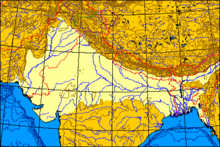
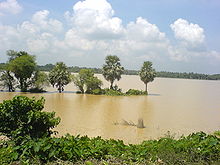
The Indo-Gangetic[23] plains, also known as the Great Plains are large alluvial plains dominated by three main rivers, the Indus, Ganges, and Brahmaputra. They run parallel to the Himalayas, from Jammu and Kashmir in the west to Assam in the east, and drain most of northern and eastern India. The plains encompass an area of 700,000 किमी2 (270,000 वर्ग मील). The major rivers in this region are the Ganges, Indus, and Brahmaputra along with their main tributaries—Yamuna, Chambal, Gomti, Ghaghara, Kosi, Sutlej, Ravi, Beas, Chenab, and Tista—as well as the rivers of the Ganges Delta, such as the Meghna.
The great plains are sometimes classified into four divisions:
- The Bhabar belt is adjacent to the foothills of the Himalayas and consists of boulders and pebbles which have been carried down by streams. As the porosity of this belt is very high, the streams flow underground. The Bhabar is generally narrow with its width varying between 6 से 15 किमी (3.7 से 9.3 मील).
- The Tarai belt lies south of the adjacent Bhabar region and is composed of newer alluvium. The underground streams reappear in this region. The region is excessively moist and thickly forested. It also receives heavy rainfall throughout the year and is populated with a variety of wildlife.
- The Bangar belt consists of older alluvium and forms the alluvial terrace of the flood plains. In the Gangetic plains, it has a low upland covered by laterite deposits.
- The Khadar belt lies in lowland areas after the Bangar belt. It is made up of fresh newer alluvium which is deposited by the rivers flowing down the plain.
The Indo-Gangetic belt is the world's most extensive expanse of uninterrupted alluvium formed by the deposition of silt by the numerous rivers. The plains are flat making it conducive for irrigation through canals. The area is also rich in ground water sources. The plains are one of the world's most intensely farmed areas. The main crops grown are rice and wheat, which are grown in rotation. Other important crops grown in the region include maize, sugarcane and cotton. The Indo-Gangetic plains rank among the world's most densely populated areas.
Thar Desert
[संपादन करीं]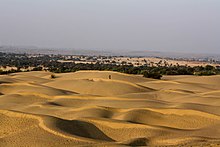
The Thar Desert (also known as the deserts) is by some calculations the world's seventh largest desert, by some others the tenth.[24] It forms a significant portion of western India and covers an area of 200,000 से 238,700 किमी2 (77,200 से 92,200 वर्ग मील).[25] The desert continues into Pakistan as the Cholistan Desert. Most of the Thar Desert is situated in Rajasthan, covering 61% of its geographic area.
About 10 percent of this region consists of sand dunes, and the remaining 90 percent consist of craggy rock forms, compacted salt-lake bottoms, and interdunal and fixed dune areas. Annual temperatures can range from 0 °C (32 °F) in the winter to over 50 °C (122 °F) during the summer. Most of the rainfall received in this region is associated with the short July–September southwest monsoon that brings 100 से 500 मिमी (0.33 से 1.64 फीट) of precipitation. Water is scarce and occurs at great depths, ranging from 30 से 120 मीटर (98 से 394 फीट) below the ground level.[26] Rainfall is precarious and erratic, ranging from below 120 मिमी (4.7 इंच) in the extreme west to 375 मिमी (14.8 इंच) eastward. The only river in this region is Luni. The soils of the arid region are generally sandy to sandy-loam in texture. The consistency and depth vary as per the topographical features. The low-lying loams are heavier may have a hard pan of clay, calcium carbonate or gypsum.
In western India, the Kutch region in Gujarat and Koyna in Maharashtra are classified as a Zone IV region (high risk) for earthquakes. The Kutch city of Bhuj was the epicentre of the 2001 Gujarat earthquake, which claimed the lives of more than 1,337 people and injured 166,836 while destroying or damaging near a million homes.[27] The 1993 Latur earthquake in Maharashtra killed 7,928 people and injured 30,000.[28] Other areas have a moderate to low risk of an earthquake occurring.[29]
Coastal plains and ghats
[संपादन करीं]

The Eastern Coastal Plain is a wide stretch of land lying between the Eastern Ghats and the oceanic boundary of India. It stretches from Tamil Nadu in the south to West Bengal in the east. The Mahanadi, Godavari, Kaveri, and Krishna rivers drain these plains. The temperature in the coastal regions often exceeds 30 °C (86 °F), and is coupled with high levels of humidity. The region receives both the northeast monsoon and southwest monsoon rains. The southwest monsoon splits into two branches, the Bay of Bengal branch and the Arabian Sea branch. The Bay of Bengal branch moves northwards crossing northeast India in early June. The Arabian Sea branch moves northwards and discharges much of its rain on the windward side of Western Ghats. Annual rainfall in this region averages between 1,000 आ 3,000 मिमी (39 आ 118 इंच). The width of the plains varies between 100 आ 130 किमी (62 आ 81 मील).[30] The plains are divided into six regions—the Mahanadi delta, the southern Andhra Pradesh plain, the Krishna-Godavari deltas, the Kanyakumari coast, the Coromandel Coast, and sandy coastal.[प्रमाण देईं]
The Western Coastal Plain is a narrow strip of land sandwiched between the Western Ghats and the Arabian Sea, ranging from 50 से 100 किमी (31 से 62 मील) in width. It extends from Gujarat in the north and extends through Maharashtra, Goa, Karnataka, and Kerala. Numerous rivers and backwaters inundate the region. Mostly originating in the Western Ghats, the rivers are fast-flowing, usually perennial, and empty into estuaries. Major rivers flowing into the sea are the Tapti, Narmada, Mandovi and Zuari. Vegetation is mostly deciduous, but the Malabar Coast moist forests constitute a unique ecoregion. The Western Coastal Plain can be divided into two parts, the Konkan and the Malabar Coast.
Islands
[संपादन करीं]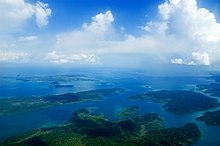
The Lakshadweep and the Andaman and Nicobar Islands are India's two major island formations and are classified as union territories.
The Lakshadweep Islands lie 200 से 440 किमी (120 से 270 मील) off the coast of Kerala in the Arabian sea with an area of 32 किमी2 (12 वर्ग मील). They consist of twelve atolls, three reefs, and five submerged banks, with a total of about 35 islands and islets.
The Andaman and Nicobar Islands are located between 6° and 14° north latitude and 92° and 94° east longitude.[31] They consist of 572 islands, lying in the Bay of Bengal near the Myanmar coast running in a north–south axis for approximately 910 km. They are located 1,255 किमी (780 मील) from Kolkata (Calcutta) and 193 किमी (120 मील) from Cape Negrais in Burma.[31] The territory consists of two island groups, the Andaman Islands and the Nicobar Islands. The Andaman and Nicobar Islands consist of 572 islands which run in a north–south axis for around 910 km. The Andaman group has 325 islands which cover an area of 6,170 km2 (2,382 sq mi) while the Nicobar group has only 247 islands with an area of 1,765 km2 (681 sq mi). India's only active volcano, Barren Island is situated here. It last erupted in 2017. The Narcondum is a dormant volcano and there is a mud volcano at Baratang. Indira Point, India's southernmost land point, is situated in the Nicobar islands at 6°45’10″N and 93°49’36″E, and lies just 189 किमी (117 मील) from the Indonesian island of Sumatra, to the southeast. The highest point is Mount Thullier at 642 मी (2,106 फीट).
Other significant islands in India include Diu, a former Portuguese colony; Majuli,[32] a river island of the Brahmaputra; Elephanta in Bombay Harbour; and Sriharikota, a barrier island in Andhra Pradesh. Salsette Island is India's most populous island on which the city of Mumbai (Bombay) is located. Forty-two islands in the Gulf of Kutch constitute the Marine National Park.
Natural resources
[संपादन करीं]Ecological resources
[संपादन करीं]Water bodies
[संपादन करीं]India has around 14,500 km of inland navigable waterways.[33] There are twelve rivers which are classified as major rivers, with the total catchment area exceeding 2,528,000 किमी2 (976,000 वर्ग मील).[18] All major rivers of India originate from one of the three main watersheds:[18]
- The Himalaya and the Karakoram ranges
- Vindhya and Satpura range in central India
- Sahyadri or Western Ghats in western India
The Himalayan river networks are snow-fed and have a perennial supply throughout the year. The other two river systems are dependent on the monsoons and shrink into rivulets during the dry season. The Himalayan rivers that flow westward into Punjab are the Indus, Jhelum, Chenab, Ravi, Beas, and Sutlej.[34]

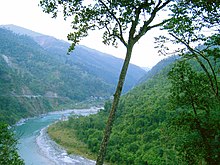
The Ganges-Brahmaputra-Meghana system has the largest catchment area of about 1,600,000 किमी2 (620,000 वर्ग मील).[35] The Ganges Basin alone has a catchment of about 1,100,000 किमी2 (420,000 वर्ग मील).[18] The Ganges originates from the Gangotri Glacier in Uttarakhand.[34] It flows southeast, draining into the Bay of Bengal.[18] (The Yamuna and Gomti rivers also arise in the western Himalayas and join the Ganges in the plains.[18] The Brahmaputra originates in Tibet, China, where it is known as the Yarlung Tsangpo River) (or "Tsangpo"). It enters India in the far-eastern state of Arunachal Pradesh, then flows west through Assam. The Brahmaputra merges with the Ganges in Bangladesh, where it is known as the Jamuna River.[18][36]
The Chambal, another tributary of the Ganges, via the Yamuna, originates from the Vindhya-Satpura watershed. The river flows eastward. Westward-flowing rivers from this watershed are the Narmada and Tapi, which drain into the Arabian Sea in Gujarat. The river network that flows from east to west constitutes 10% of the total outflow.[स्पष्टीकरण जरूरी]

(The Western Ghats are the source of all Deccan rivers, which include the through Godavari River, Krishna River and Kaveri River, all draining into the Bay of Bengal. These rivers constitute 20% of India's total outflow).[34]
The heavy southwest monsoon rains cause the Brahmaputra and other rivers to distend their banks, often flooding surrounding areas. Though they provide rice paddy farmers with a largely dependable source of natural irrigation and fertilisation, such floods have killed thousands of people and tend to cause displacements of people in such areas.
Major gulfs include the Gulf of Cambay, Gulf of Kutch, and the Gulf of Mannar. Straits include the Palk Strait, which separates India from Sri Lanka; the Ten Degree Channel, which separates the Andamans from the Nicobar Islands; and the Eight Degree Channel, which separates the Laccadive and Amindivi Islands from the Minicoy Island to the south. Important capes include the Kanyakumari (formerly called Cape Comorin), the southern tip of mainland India; Indira Point, the southernmost point in India (on Great Nicobar Island); Rama's Bridge, and Point Calimere. The Arabian Sea lies to the west of India, the Bay of Bengal and the Indian Ocean lie to the east and south, respectively. Smaller seas include the Laccadive Sea and the Andaman Sea. There are four coral reefs in India, located in the Andaman and Nicobar Islands, the Gulf of Mannar, Lakshadweep, and the Gulf of Kutch.[37] Important lakes include Sambhar Lake, the country's largest saltwater lake in Rajasthan, Vembanad Lake in Kerala, Kolleru Lake in Andhra Pradesh, Loktak Lake in Manipur, Dal Lake in Kashmir, Chilka Lake (lagoon lake) in Odisha, and Sasthamkotta Lake in Kerala.
Wetlands
[संपादन करीं]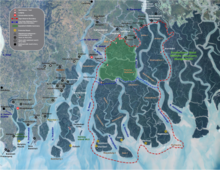

India's wetland ecosystem is widely distributed from the cold and arid located in the Ladakh region of Jammu and Kashmir, and those with the wet and humid climate of peninsular India. Most of the wetlands are directly or indirectly linked to river networks. The Indian government has identified a total of 71 wetlands for conservation and are part of sanctuaries and national parks.[38] Mangrove forests are present all along the Indian coastline in sheltered estuaries, creeks, backwaters, salt marshes and mudflats. The mangrove area covers a total of 4,461 किमी2 (1,722 वर्ग मील),[39] which comprises 7% of the world's total mangrove cover. Prominent mangrove covers are located in the Andaman and Nicobar Islands, the Sundarbans delta, the Gulf of Kutch and the deltas of the Mahanadi, Godavari and Krishna rivers. Parts of Maharashtra, Karnataka and Kerala also have large mangrove covers.[37]
The Sundarbans delta is home to the largest mangrove forest in the world. It lies at the mouth of the Ganges and spreads across areas of Bangladesh and West Bengal. The Sundarbans is a UNESCO World Heritage Site, but is identified separately as the Sundarbans (Bangladesh) and the Sundarbans National Park (India). The Sundarbans are intersected by a complex network of tidal waterways, mudflats and small islands of salt-tolerant mangrove forests. The area is known for its diverse fauna, being home to a large variety of species of birds, spotted deer, crocodiles and snakes. Its most famous inhabitant is the Bengal tiger. It is estimated that there are now 400 Bengal tigers and about 30,000 spotted deer in the area.
The Rann of Kutch is a marshy region located in northwestern Gujarat and the bordering Sindh province of Pakistan. It occupies a total area of 27,900 किमी2 (10,800 वर्ग मील).[40] The region was originally a part of the Arabian Sea. Geologic forces such as earthquakes resulted in the damming up of the region, turning it into a large saltwater lagoon. This area gradually filled with silt thus turning it into a seasonal salt marsh. During the monsoons, the area turn into a shallow marsh, often flooding to knee-depth. After the monsoons, the region turns dry and becomes parched.
Economic resources
[संपादन करीं]Renewable water resources
[संपादन करीं]India's total renewable water resources are estimated at 1,907.8 km3 a year.[41] Its annual supply of usable and replenshable groundwater amounts to 350 billion cubic metres.[42] Only 35% of groundwater resources are being utilised.[42] About 44 million tonnes of cargo is moved annually through the country's major rivers and waterways.[33] Groundwater supplies 40% of water in India's irrigation canals. 56% of the land is arable and used for agriculture. Black soils are moisture-retentive and are preferred for dry farming and growing cotton, linseed, etc. Forest soils are used for tea and coffee plantations. Red soils have a wide diffusion of iron content.[43]
Mineral oil
[संपादन करीं]Most of India's estimated 5.4 billion barrels (860,000,000 मी3) in oil reserves are located in the Mumbai High, upper Assam, Cambay, the Krishna-Godavari and Cauvery basins.[44] India possesses about seventeen trillion cubic feet of natural gas in Andhra Pradesh, Gujarat and Odisha.[44] Uranium is mined in Andhra Pradesh. India has 400 medium-to-high enthalpy thermal springs for producing geothermal energy in seven "provinces"—the Himalayas, Sohana, Cambay, the Narmada-Tapti delta, the Godavari delta and the Andaman and Nicobar Islands (specifically the volcanic Barren Island.)[45]
Minerals and ores
[संपादन करीं]
India is the world's biggest producer of mica blocks and mica splittings.[46] India ranks second amongst the world's largest producers of barite and chromite.[46] The Pleistocene system is rich in minerals. India is the third-largest coal producer in the world and ranks fourth in the production of iron ore.[44][46] It is the fifth-largest producer of bauxite, second largest of crude steel as of February 2018 replacing Japan, the seventh-largest of manganese ore and the eighth-largest of aluminium.[46] India has significant sources of titanium ore, diamonds and limestone.[47] India possesses 24% of the world's known and economically viable thorium, which is mined along shores of Kerala.[48] Gold had been mined in the now-defunct Kolar Gold Fields in Karnataka.[49]
Climate
[संपादन करीं]
Based on the Köppen system, India hosts six major climatic subtypes, ranging from arid desert in the west, alpine tundra and glaciers in the north, and humid tropical regions supporting rainforests in the southwest and the island territories. The nation has four seasons: winter (January–February), summer (March–May), a monsoon (rainy) season (June–September) and a post-monsoon period (October–December).[34]
The Himalayas act as a barrier to the frigid katabatic winds flowing down from Central Asia. Thus, northern India is kept warm or only mildly cooled during winter; in summer, the same phenomenon makes India relatively hot. Although the Tropic of Cancer—the boundary between the tropics and subtropics—passes through the middle of India, the whole country is considered to be tropical.[51]
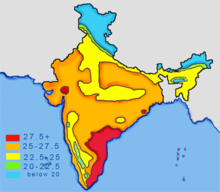
Summer lasts between March and June in most parts of India. Temperatures can exceed 40 °C (104 °F) during the day. The coastal regions exceed 30 °C (86 °F) coupled with high levels of humidity. In the Thar desert area temperatures can exceed 45 °C (113 °F). The rain-bearing monsoon clouds are attracted to the low-pressure system created by the Thar Desert. The southwest monsoon splits into two arms, the Bay of Bengal arm and the Arabian Sea arm. The Bay of Bengal arm moves northwards crossing northeast India in early June. The Arabian Sea arm moves northwards and deposits much of its rain on the windward side of Western Ghats. Winters in peninsula India see mild to warm days and cool nights. Further north the temperature is cooler. Temperatures in some parts of the Indian plains sometimes fall below freezing. Most of northern India is plagued by fog during this season. The highest temperature recorded in India was 51 °C (124 °F) in Phalodi, Rajasthan. .[52] And the lowest was −60 °C (−76 °F) in Dras, Jammu and Kashmir.[53]
Geology
[संपादन करीं]
India's geological features are classified based on their era of formation.[54] The Precambrian formations of Cudappah and Vindhyan systems are spread out over the eastern and southern states. A small part of this period is spread over western and central India.[54] The Paleozoic formations from the Cambrian, Ordovician, Silurian and Devonian system are found in the Western Himalaya region in Kashmir and Himachal Pradesh.[54] The Mesozoic Deccan Traps formation is seen over most of the northern Deccan; they are believed to be the result of sub-aerial volcanic activity.[54] The Trap soil is black in colour and conducive to agriculture. The Carboniferous system, Permian System and Triassic systems are seen in the western Himalayas. The Jurassic system is seen in the western Himalayas and Rajasthan.
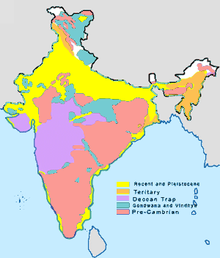
Tertiary imprints are seen in parts of Manipur, Nagaland, Arunachal Pradesh and along the Himalayan belt. The Cretaceous system is seen in central India in the Vindhyas and part of the Indo-Gangetic plains.[54] The Gondwana system is seen in the Narmada River area in the Vindhyas and Satpuras. The Eocene system is seen in the western Himalayas and Assam. Oligocene formations are seen in Kutch and Assam.[54] The Pleistocene system is found over central India. The Andaman and Nicobar Island are thought to have been formed in this era by volcanoes.[54] The Himalayas were formed by the convergence and deformation of the Indo-Australian and Eurasian Plates. Their continued convergence raises the height of the Himalayas by one centimetre each year.
Soils in India can be classified into eight categories: alluvial, black, red, laterite, forest, arid and desert, saline and alkaline and peaty and organic soils.[55][56] Alluvial soil constitute the largest soil group in India, constituting 80% of the total land surface.[56] It is derived from the deposition of silt carried by rivers and are found in the Great Northern plains from Punjab to the Assam valley.[56] Alluvial soil are generally fertile but they lack nitrogen and tend to be phosphoric.[56] National Disaster Management Authority says that 60% of Indian landmass is prone to earthquakes and 8% susceptible to cyclone risks.
Black soil are well developed in the Deccan lava region of Maharashtra, Gujarat, and Madhya Pradesh.[43] These contain high percentage of clay and are moisture retentive.[56] Red soils are found in Tamil Nadu, Karnataka plateau, Andhra plateau, Chota Nagpur plateau and the Aravallis.[43] These are deficient in nitrogen, phosphorus and humus.[56][43] Laterite soils are formed in tropical regions with heavy rainfall. Heavy rainfall results in leaching out all soluble material of top layer of soil. These are generally found in Western ghats, Eastern ghats and hilly areas of northeastern states that receive heavy rainfall. Forest soils occur on the slopes of mountains and hills in Himalayas, Western Ghats and Eastern Ghats. These generally consist of large amounts of dead leaves and other organic matter called humus.
संदर्भ
[संपादन करीं]- ↑ 1.0 1.1 "Annual Report 2016-17, Ministry of Home Affairs" (PDF). Archived from the original (PDF) on 7 March 2018. Retrieved 7 March 2018.
- ↑ India Yearbook, p. 1
- ↑ "India". Encyclopædia Britannica. Retrieved 17 July 2012. एह में ऊ एरिया शामिल ना बा जे वर्तमान में भारत के कंट्रोल में नइखे।
- ↑ "India at a Glance: Area". Ministry of Home Affairs: Government of India. 2001. Retrieved 9 September 2020.
- ↑ "Jammu and Kashmir - CIA" (PDF). Central Intelligence Agency. 2002. Retrieved 9 September 2020.
- ↑ "Manorama Yearbook 2006 (India – The Country)". Manorama Year Book. Malayala Manorama: 515. 2006. ISSN 0542-5778.
- ↑ "Territorial extent of India's waters". The International Law of the Sea and Indian MaritimeLegislation. 30 April 2005. Archived from the original on 28 September 2007. Retrieved 16 May 2006.
- ↑ Cratons of India.
- ↑ Cratons of India, lyellcollection.org.
- ↑ Baker, Kathleen M.; Chapman, Graham P. (11 March 2002), The Changing Geography of Asia, Routledge, pp. 10–, ISBN 978-1-134-93384-6,
This greater India is well defined in terms of topography; it is the Indian sub-continent, hemmed in by the Himalayas on the north, the Hindu Khush in the west and the Arakanese in the east.
- ↑ Measurements are from recent imagery, generally supplemented with Russian 1:200,000 scale topographic mapping as well as Jerzy Wala, Orographical Sketch Map: Karakoram: Sheets 1 & 2, Swiss Foundation for Alpine Research, Zurich, 1990.
- ↑ "Physical divisions" (PDF). Archived from the original (PDF) on 12 December 2004.
- ↑ Dale Hoiberg; Indu Ramchandani (2000). Students' Britannica India. Popular Prakashan. pp. 92–93. ISBN 978-0-85229-760-5.
- ↑ Gupta, Harsh K; Aloka Parasher-Sen; Dorairajan Balasubramanian (2000). Deccan Heritage. Orient Blackswan. p. 28. ISBN 81-7371-285-9.
- ↑ Sharma, Hari Shanker (1987). Tropical geomorphology: a morphogenetic study of Rajasthan. Concept. p. 295. ISBN 81-7022-041-6.
- ↑ 16.0 16.1 16.2 "Manorama Yearbook 2006 (India – The Country)". Manorama Year Book. Malayala Manorama: 516. 2006. ISSN 0542-5778.
- ↑ The Indian geographical journal. Vol. 46. Indian Geographical Society. 1971. p. 52.
- ↑ 18.00 18.01 18.02 18.03 18.04 18.05 18.06 18.07 18.08 18.09 Manorama Yearbook 2006 (India – The Country). p. 517.
- ↑ "The Deccan Plateau". How Stuff Works. Archived from the original on 8 January 2009. Retrieved 14 November 2008.
- ↑ Clayton, Pamela (November 2006). "Introduction". Literacy in Kerala. Hindimetyari. ISBN 0-86389-068-7. Archived from the original on 23 November 2018. Retrieved 22 November 2018.
- ↑ Pullaiah, Thammineni; D.Muralidhara Rao (2002). "Preface". Flora of Eastern Ghats: Hill ranges of south east India. Vol. 1. Daya Books. p. 1. ISBN 81-87498-49-8.
- ↑ Kenneth Pletcher (2010). The Geography of India: Sacred and Historic Places. The Rosen Publishing Group. p. 28. ISBN 978-16-1530-142-3.
- ↑ "Geography Now! India". Youtube. Archived from the original on 2021-12-11.
- ↑ "The World's Largest Desert". geology.com. Retrieved 14 May 2011.
- ↑ "Thar Desert". Encyclopædia Britannica. Retrieved 14 May 2011.
- ↑ Kaul, R.N. (1970). Afforestation in Arid zones. N.V. Publishers, The Hague.
- ↑ "Preliminary Earthquake Report". USGS Earthquake Hazards Program. Archived from the original on 20 November 2007. Retrieved 21 November 2007.
- ↑ Brijesh Gulati (January 2006). "Earthquake Risk Assessment of Buildings: Applicability of HAZUS in Dehradun, India" (PDF). Indian Institute of Remote Sensing, National Remote Sensing Agency. Archived from the original (PDF) on 28 May 2008. Retrieved 19 November 2008.
{{cite journal}}: Cite journal requires|journal=(help) - ↑ Manorama Yearbook 2006 (India – The Country). p. 519.
- ↑ "The Eastern Coastal Plain". Rainwaterharvesting.org. Retrieved 19 November 2008.
- ↑ 31.0 31.1 "National Portal of India: Know India: State of UTs". Government of India. Archived from the original on 19 June 2010. Retrieved 19 November 2008.
- ↑ Majuli, River Island. "Largest river island". Guinness World Records. Retrieved 6 September 2016.
- ↑ 33.0 33.1 "Introduction to Inland Water Transport". Government of India. Archived from the original on 9 July 2012. Retrieved 19 November 2008.
- ↑ 34.0 34.1 34.2 34.3 Manorama Yearbook 2006 (India – The Country). p. 518.
- ↑ Elhance, Arun P. (1999). Hydropolitics in the Third World: conflict and cooperation in international river basins. US Institute of Peace Press. pp. 156–158. ISBN 978-1-878379-91-7.
- ↑ Brahmaputra River, Encyclopædia Britannica
- ↑ 37.0 37.1 Manorama Yearbook 2006 (India – Environment). p. 580.
- ↑ India Yearbook, p. 306
- ↑ India Yearbook, p. 309
- ↑ World Wildlife Fund (2001). "Rann of Kutch". WildWorld Ecoregion Profile. National Geographic Society. Archived from the original on 2010-03-08.
- ↑ "Water profile of India". Encyclopedia of Earth. Retrieved 20 November 2008.
- ↑ 42.0 42.1 Jain, J.K.; Farmer, B. H.; Rush, H.; West, H. W.; Allan, J. A.; Dasgupta, B.; Boon, W. H. (May 1977). "India's Underground Water Resources". Philosophical Transactions of the Royal Society of London. 278 (962): 507–22. doi:10.1098/rstb.1977.0058.
- ↑ 43.0 43.1 43.2 43.3 "Krishi World website". Krishiworld.com. Archived from the original on 9 June 2007. Retrieved 18 July 2007.
- ↑ 44.0 44.1 44.2 "Energy profile of India". Encyclopedia of Earth. Retrieved 20 November 2008.
- ↑ Chandrasekharam, D. "Geothermal Energy Resources of India". Indian Institute of Technology Bombay. Archived from the original on 17 December 2008. Retrieved 2 November 2008.
- ↑ 46.0 46.1 46.2 46.3 "India's Contribution to the World's Mineral Production". Ministry of Mines, Government of India. Archived from the original on 16 December 2008. Retrieved 20 November 2008.
- ↑ "India". CIA Factbook. Retrieved 16 June 2007.
- ↑ "Information and Issue Briefs – Thorium". World Nuclear Association. Archived from the original on 7 November 2006. Retrieved 1 June 2006.
- ↑ "Death of the Kolar Gold Fields". Rediff.com. Retrieved 21 November 2008.
- ↑ Peel, M. C. and Finlayson, B. L. and McMahon, T. A. (2007). "Updated world map of the Köppen–Geiger climate classification". Hydrol. Earth Syst. Sci. 11 (5): 1633–1644. doi:10.5194/hess-11-1633-2007. ISSN 1027-5606.
{{cite journal}}: CS1 maint: multiple names: authors list (link) (direct: Final Revised Paper) - ↑ Climate Change: Myths and Realities. Jeevananda Reddy. p. 65. GGKEY:WDFHBL1XHK3.
- ↑ "India sets new heat record as temperatures soar". Channel NewsAsia. Archived from the original on 21 May 2016. Retrieved 2016-05-20.
- ↑ Binayak, Poonam. "Dras: The World's Second Coldest Inhabited Place". Culture Trip. Retrieved 2020-11-23.
- ↑ 54.0 54.1 54.2 54.3 54.4 54.5 54.6 Manorama Yearbook 2006 (India – Geology). p. 521.
- ↑ "India Agronet – Soil Management". Indiagronet.com. Retrieved 18 July 2007.
- ↑ 56.0 56.1 56.2 56.3 56.4 56.5 "Fertilizer use by crop in India". U.S. Food and Agriculture Organization. Retrieved 2 August 2007.



